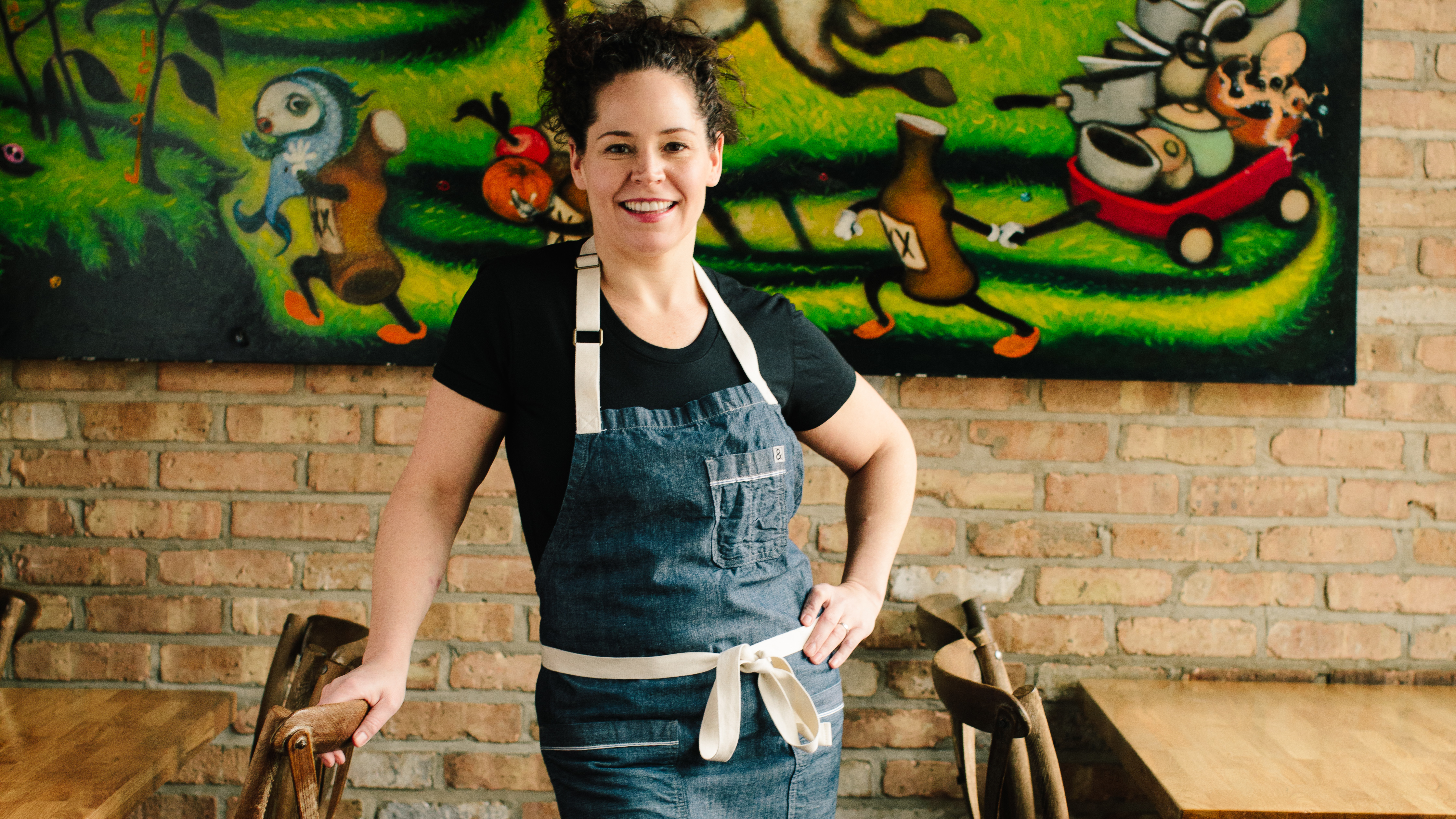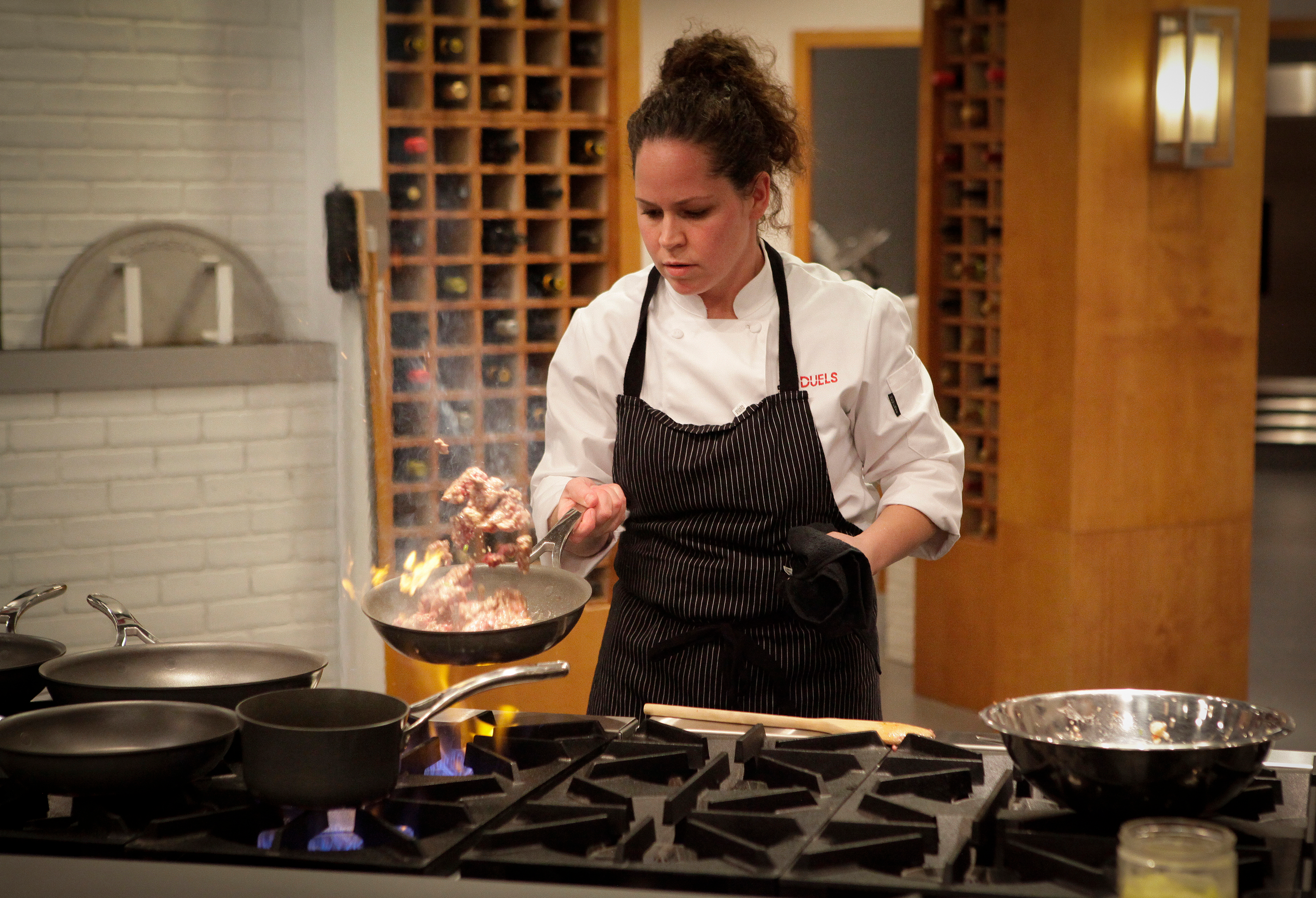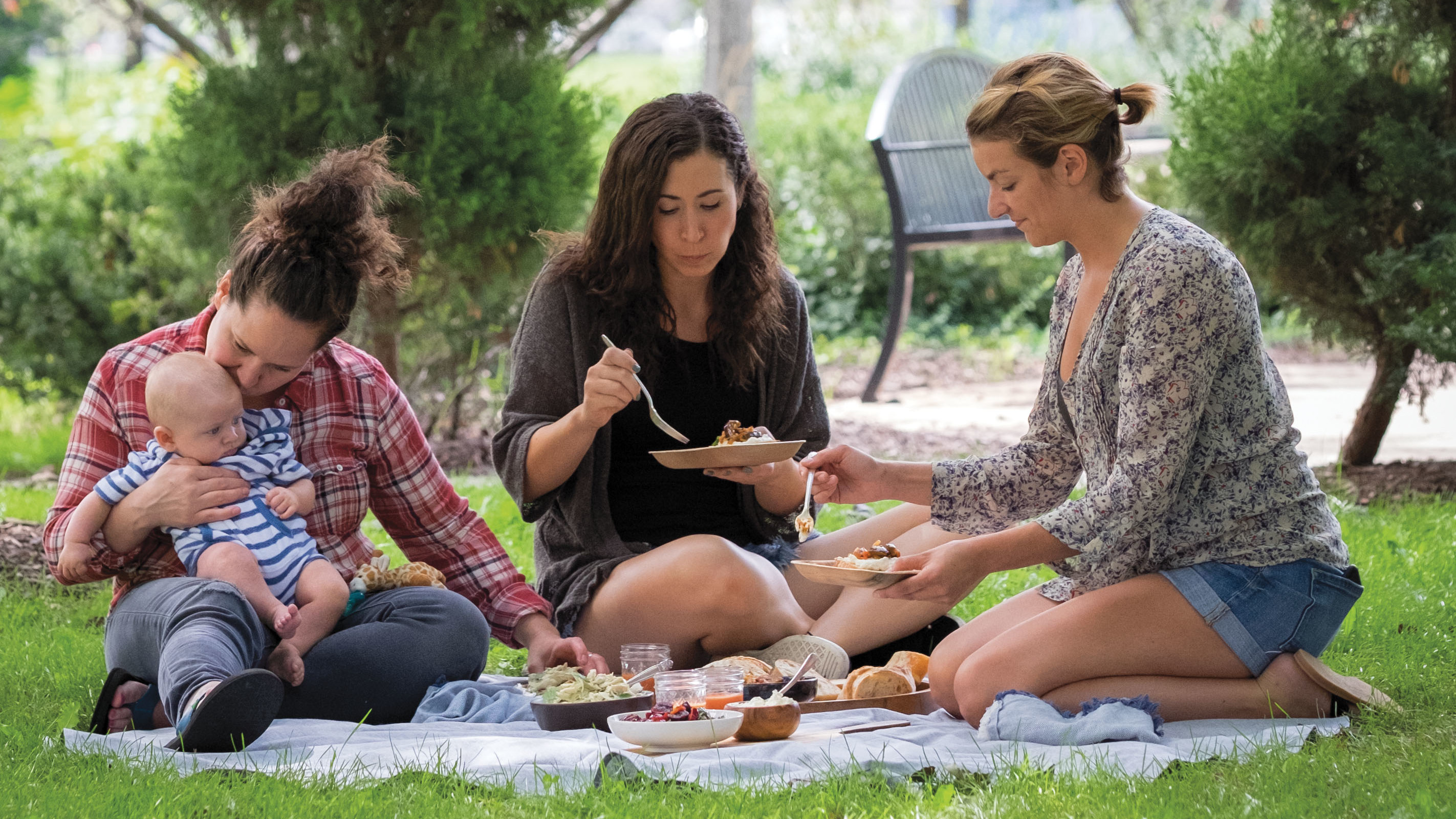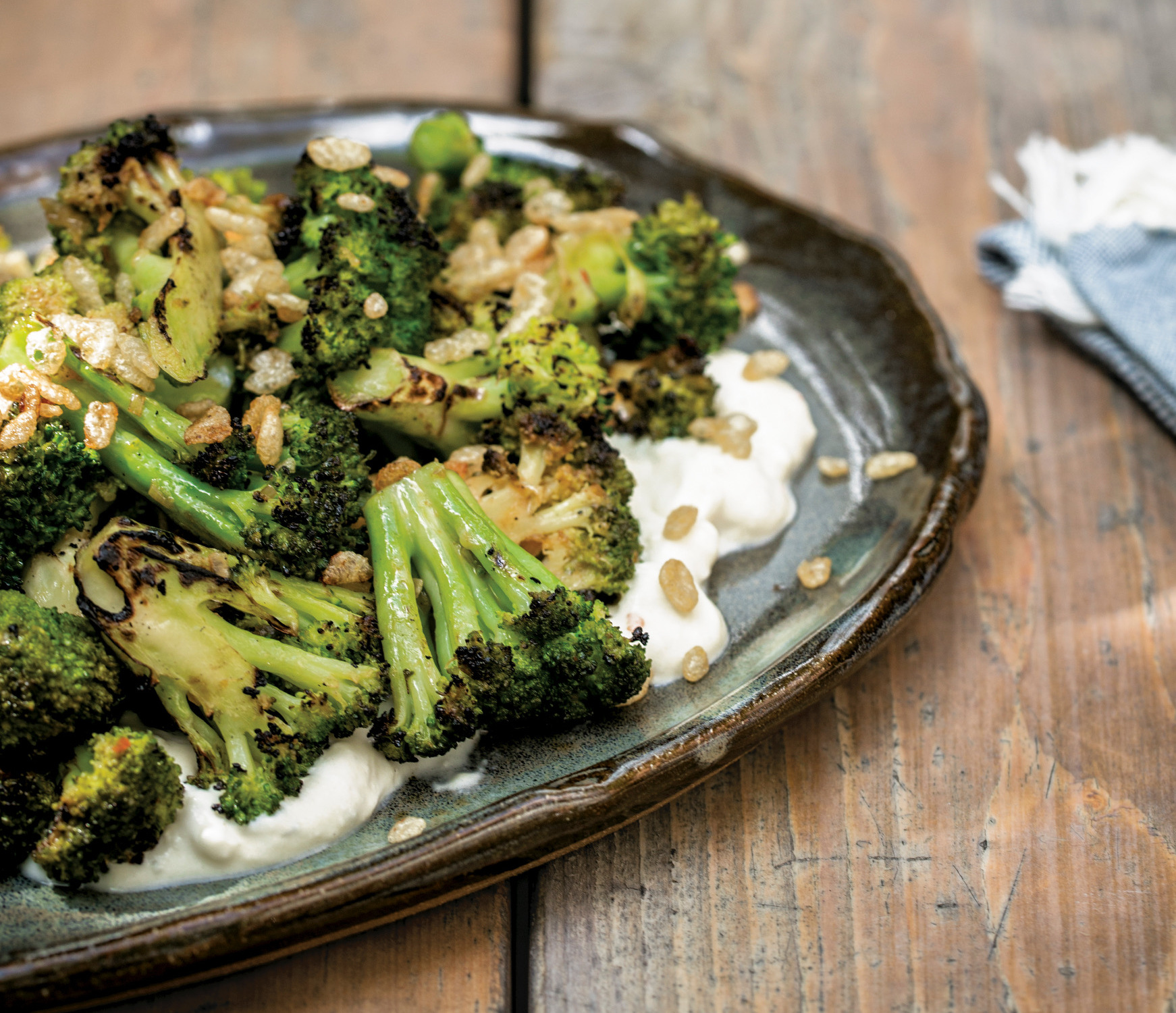Stephanie Izard Has Tips For Becoming A Top Chef At Home
Even among considerable rock stars in the cooking industry, Stephanie Izard is like the Top Chef of Top Chefs. She's a James Beard Award-winner. She was the first woman to win Bravo's Top Chef, during season four. She also won "Fan Favorite" that season, so far the only Top Chef to do so. Last year, she defeated chefs Michael Symon and Masaharu Morimoto to become Iron Chef on Food Network's Iron Chef Gauntlet.

When she's not kicking ass on TV, Izard is busily running her own three award-winning Chicago restaurants: Girl & The Goat, Little Goat, and Duck Duck Goat. And she recently released the followup to her 2011 cookbook with Gather & Graze: 120 Favorite Recipes For Tasty Good Times. She and her husband Gary, a beer consultant, have a 2-year-old at home, Ernie, as well as their dog Burt.
As busy as she is, Izard took time to sit down with The Takeout and tell us how to wow our friends and family like a culinary master. Gather & Graze focuses on how to translate Izard's food to your own dining table. She favors unexpected meats like goat neck, for example (Girl & The Goat's menu has a whole goat section), vegetables like fish-sauced green beans and smoky broccoli, as well as fearless combinations like pickled rhubarb with a sour cream ice cream, or adding rice crisps or even Cheez-Its in unexpected places (her own wedding cake featured a combination of Cheez-Its and Strawberry Nesquik). So we asked Izard for her own shortcuts to help make our own dinners and dinner parties gourmet-worthy, with a bit of her creative edge.
Tip# 1: Take shortcuts where you need them
Izard doesn't hesitate to say she uses store-bought mayonnaise for quick dressing, sandwich schmears, and marinades, often mixing it together with other condiments in her pantry. "I'll look into my condiments area and I'll take a little bit of mayonnaise and some barbecue sauce and some A-1... I mix them all together, and make marinades with that. It's super fun to mix-match your condiments marinade."
I asked Izard if she had a favorite prepared condiments match-up. "I think a little bit of mayonnaise—I like the ranch, the barbecue, and a little bit of fish sauce. I use that most for chicken or pork. But having that little bit of ranch or mayonnaise in it helps it stick to the meat and it's really tasty."
She saves time by using store-bought items and "enhancing" with other flavors, like using a jar of pasta sauce but adding fresh onions and garlic and ground beef. She continued, "Something yummy that you can make with store-bought spaghetti is if you toast it and break it into pieces, and then you cook it more fideo-style. You cook it with stock instead of water and start by sautéeing onions and put in your broken-up, toasted pasta, and then you add in a little stock at a time—even chicken stock would work—we do with shrimp stock in the restaurants. And the pasta itself just soaks up all that yummy flavor. That's how they cook pasta in Spain; it's really awesome."
Tip #2: Re-use your food in imaginative ways
Speaking of mayonnaise, another thing Gather & Graze suggests is to take leftover marinade, mix it with mayonnaise, and create a sauce or a sandwich spread. With a 2-year-old at home, Izard is all about repurposing.
"When you have kids, we end up having all this food around all the time, but we're really trying to be a little more strategic about reinventing leftovers. Like leftover pancakes—we made a melted chocolate ganache and a pancake layer cake—it's delicious on its own.
"There's a soup that actually one of my cooks at Little Goat made me the other day using some of the leftover masa chips. If you make a bunch and your friends don't eat them all, you can use them for soup the next day. Or there's a grilled carrots recipe in here. And when you have four grilled carrots left over, you're probably going to pitch them, because you're like, 'What are we going to do with these grilled carrots?' But turning them into a vinaigrette—there's just things you can do with little bits of food.
"Oh," she continues, flipping through the book, "this would be a good thing to use, come the fall... just taking this idea of croissants and stock makes the best turkey gravy."
"Okay," I said, "How do you come up with something like that?"
"I was trying to come up with a new soup of the day, and we always have these leftover croissants at Little Goat, so I put them in some chicken stock and simmered it and pureed it, and we all took a bite and were like, [in hushed tones] 'This is the best turkey gravy I've ever had.' So in the winter, we have mashed potatoes and gravy on the menu at Little Goat all the time and instead of making a roux and doing that whole thing—there's a lot of ways to get that messed up and not be consistent—we just started to make croissant gravy. It was the same every time and it was delicious."
Tip #3: Experiment with unexpected combos
Izard's book, as well as her restaurant menu, are full of unexpected pairings. For example, her chocolate mousse with black olive caramel. Izard explains, "That olive with caramel I actually made for the first time years ago at my first restaurant when I was 27, so it was, like, 15 years ago. And I served it with tuna, so it was more so putting something sweet with something savory. And then my pastry chef at Girl & The Goat—we were talking about a chocolate dessert—I made him the olive caramel and he was like, 'Love it.' He likes making bleu cheese caramels and cashew caramel and different flavored caramels, so we made the olive caramel together, and it just tasted so great with chocolate, because you're getting the sweetness, but you're getting sort of that earthiness.
"For me, it's all about always thinking about the different parts of your palate and satisfying those. So it's about having something sweet in every dish, even if it's a savory dish, something that's a bit spicy. But that's where fruit makes its way into a lot of my savory cooking, because it adds that little bit of sweet and acidity that otherwise would be missing." You'll notice that Izard's Goat-o Goat-o Salad has a bit of nectarine alongside the carrots, for example. "Once you understand what the purpose of an ingredient is in a dish, you can sub in some different things and start trying to create in a similar way."
Tip #4: Don’t forget texture
One thing that's obvious while going through Izard's book is how much she cares about texture. She goes off a few times on things that get too "goopy," and adds various items for a crunchy texture in everything from salads to desserts. She explains the origin behind that Rice Krispie-broccoli combo: "We have had the grilled broccoli on at Girl & The Goat for a while, and we used to do crispy fried onions on top. So we were at these people's house cooking and I didn't want to set up a fryer in their house just to fry the topping, and we were in Florida, and I was thinking it might be really hard to get things crunchy in a humid place. So we went to the store and were just walking around, and I was like, 'Rice Krispies! Let's just get those.' We cooked them with a spice mix in the butter, and they were delicious. When you sauté them in butter, people usually just want to put it on everything."
Tip #5: Stay calm under pressure
Like many restaurants, Izard's feature an open-kitchen layout, which enables visiting diners to actually see how their food gets made. We were wondering at The Takeout, though: Doesn't that make it extra-stressful for the cooks, who not only have to go through numerous food tickets, but also have to have a poker face when they're in the weeds? Izard confirms, "I think Girl & The Goat is a great way to force yourself to learn—it took a couple of years of being very stressed out—and I'm still very stressed out—but in the restaurant, in that setting during service, to have so many different things happening and to be able to not freak out."
To remind herself, Izard kept a key memento from a cooking disaster. "We used to have this sauté pan hanging in the basement at Girl & The Goat—it had a hole burnt through the bottom. There was one day where I was trying to train all these new people at one time... I was about to smoke meat, so I put some wood chips in the pan with some water on the stove upstairs and then I went downstairs. About an hour later: 'Oh, no, I forgot about the wood chips.' I've never seen this happen—the whole bottom of the aluminum pan just burned through. So I hung it up to remind myself of this terrible day, so that when I was having a stressed-out day, I could look at that and be like, 'Well, at least it's not that day.'"
Tip #6: You can do this!
Personally, for me, the prospect of having people over for a meal I have entirely cooked myself seems a bit daunting: Somehow, nothing seems more embarrassing that having one of my famous culinary snafus in front of other people. So I'm excited to tear into Izard's book—especially as farmers' market season approaches—and start practicing. She is very encouraging, especially to the amateur home cook like me: "You can do it yourself! And don't be afraid to—especially if you've made something once—just think about trying to change it up a little.
It's also a little heartening to hear from Izard herself that not everything she creates is automatically spectacular, even at home. "When I try to cook at home, sometimes I try to be nonchalant about it, and then I make something that I'm like, 'This is not very good. I should make some effort.' I was just saying to my husband this morning, because he made some comment about cooking dinner. I was like, 'I'm the worst home cook ever.'"
Obviously untrue. But to help all of us raise our home-cooking game, Izard shares her tofu noodle salad recipe from her new book. Click here to check it out.



